September 18, 2009
While we were all reluctant to leave Phoenix, we were also anxious to get to Oswego, where we would get to see Lake Ontario; none of us has seen any of the Great Lakes. There is really so much to see in this grand country of ours!
Well, we didn't have a good send-off from Phoenix. We planned an early start and got up on time, despite some fog. We had decided to pump out the holding tank (time for me to make myself scarce), and moved FLUKE over next to the pump out without incident. We all had our doubts about how effective the pump-out machine was going to be, but Eddie said he had tried out the sucking mechanism using a bucket of water, and the pump had sucked it dry. I commented that that wasn't a fair test since the pump would have to suck a long way up out of our holding tank. Plus, the end of the suction hose had been taped and rigged. All pump out holes aren't the same diameter, so you never know what to expect.
The pump worked itself steadily, but there were too many air leaks at the tip of the hose, so we couldn't maintain a good enough suction to empty the tank. I think we tried for over an hour. Since it's free we can't complain much. At least we hadn't reached “critical mass” in the tank, and we can make it back to Waterford where we had success the first time. Plus it is cool enough now such that the ports are closed and the sewer gases aren't asphyxiating us. I haven't even heard Eddie whining about it.
The Oswego Canal locks presented a couple of different issues to deal with. They all don't have the convenient ropes to hold off to, and instead you have to run one of your own lines around a fixed vertical cable set within the lock wall. We used these in the first lock at Troy, but we were going up which meant that the cable was right next to us when we pulled into the lock. In these Oswego locks, we are going down. We have to reach from the upper midships deck with the boathook extended way out and push the line through and pull it all the way back up. I push it through and Eddie grabs it with his boat hook, lifting it off my hook. One of the lock attendants even asked if we wanted him to loop the line through when he saw how far we were from it. He was impressed when he saw how we worked out the problem. Those guys are so nice!
The other thing that takes some getting used to are these fixed bridges that cross right over the top of the lock. When we pull up, FLUKE is higher than the bridge. However, we get lowered down 20' so then we can safely pass under the bridge. When you are locking up you have to make sure no part of your boat is under the bridge where it could get crushed on the way up.
It is a pretty river trip from Phoenix to Oswego. There are a lot of waterfowl, higher end modern homes, rural landscapes, and lots of foliage. I laughed when I saw this flock of plastic flamingos out of place on the shoreline. Maybe we should give them a ride back to Florida where they would be more at home.
My first impression of Oswego didn't get off to a good start. How things changed, and I ended up being sad to leave.
After we exited Lock 7 we needed to decide where to tie up to the canal wall in the half mile space before reaching Lock 8. At least we had already decided we weren't going to go through Lock 8 and stick our bow out in Lake Ontario (hopefully we will have a trip in the future where we will get to travel a lot out on the lake), but there was much discussion about exactly where to tie up along the wall.
I don't like to be where there is a lot of noise, and when we exited Lock 7 I immediately saw 3 bridges looming overhead within the next half mile. Bridges usually mean noise. I suggested we tie off on the newly done wall with a nice railing, good cleats, and a park-like mowed grassy area close to Lock 7. Wayne said he wanted to get a closer look at the area by Lock 8, so we continued to move forward.
That area had a beat up wall, just rings embedded in the wall, instead of cleats, to tie off to, and some other undesirable features like a huge (handicap accessible) porta potty (they always stink), and 4 homeless looking vagrants sitting under one of the picnic pavilions. I told Wayne and Eddie I liked the looks of the area by Lock 7 better, but if they wanted to be right next to the outhouse and get friendly with the vagrants I could probably adjust. We ended up by Lock 7.
The following morning a police officer showed up and chased all the vagrants away; we never saw them again. I asked the officer if we and FLUKE were going to be “safe” docked where we were, and he said they had not had any trouble in the area where we were.
If you look in the photo pictured above you will see that we are docked across from a spill over. That's because the water in the foreground is the Oswego River, and the water we are on is the Oswego Canal which is 10' higher than the river. The spillover is designed to let the water that comes out of Lock 7 have a place to go when Lock 8 hasn't opened. All the locks have a bit of a flow coming out of them anyway even when they are closed. You can even see Lock 7 in the background if you look closely enough.
Two of the bridges I mentioned earlier carry road vehicles, but they have sides on them that dampen the noise. The other bridge was an old railroad bridge that has been converted into a very nice pedestrian walk over, linking the areas on the east and west side of the waterways. Both sides of the waterways have beautiful riverwalk areas that extend for over a mile and get a lot of use from walkers and fishermen.
Since the Oswego River flows into Lake Ontario salmon leave the lake to begin their migration up the river for spawning in the Fall. The migration had just begun, and we got to see some interesting fish action. I saw a big salmon jump high out of the water 3 times with a lamprey eel attached to its side. One of the fishermen hooked a salmon with an eel on it, and the hook fell out of the salmon and hooked the eel. The salmon can only go as far as the first dam they encounter which is connected to a power plant adjacent to Lock 7. Many people wade out into the water and fish right at the base of the dam. We ran into these guys early one morning as they were headed back to their cars.
It is a nice walk all the way to Lake Ontario which looked like the ocean on a couple of days when the wind was really blowing. There is a gigantic breakwater designed to protect the inner harbor and mouth of the river. The picturesque West Pierhead Lighthouse marks the end of one of the sides.
The east side of the waterway has undergone a lot of urban renewal so there area lot of new buildings, residential and commercial, right along the waterway. The commercial port activities take up space on both sides on the northern most end, closest to the lake Several murals have been painted around town depicting some important events in Oswego history, each in an appropriate location. This one is down on the waterfront.
Fort Ontario is one of the important historical sights within walking distance. The British built a wooden fort on the present day site in 1755, but that fort was destroyed by the French. The British rebuilt the fort out of earth and timber, but it was destroyed in 1778 by the American Revolutionary troops that came over from our previous tour site, Fort Stanwix (where Wayne and Eddie received their cannon firing training!). The fort continued to change hands between the two sides until it finally wound up in American hands after the war ended. The earth and timber structure was further fortified with the stone mined from the lake shore and still stands today. Fort Ontario even had some use in modern times when it served as an emergency refugee center for victims of the Nazi Holocaust in 1944-46, the only one of its kind in the U.S.
We had gone to the fort on Tuesday morning, only to find it locked up tight, and there were no signs indicating any operating hours. A grumpy old man walking around the outside grounds said he thought the fort closed after Labor Day. So, we were disappointed and decided to walk the perimeter of the fort. It is located on a high bluff overlooking Lake Ontario, so the view is captivating. We also decided to walk down to the shore of Lake Ontario.
Since we already have “criminal” records and experience in B & E, I suggested we just break into the fort (there were a couple of places in the outer wall that we could have easily scaled) and look around on our own, but Wayne didn't think it was a good idea. Eddie and I would get into a lot of trouble if Wayne wasn't around to keep us in check. We just happened to be at the entrance to the fort when the door opened and a park employee stepped out. He said that cutbacks had necessitated that the fort be closed on Mondays and Tuesdays after Labor Day. I told him that we had come by boat all the way from Florida to see the fort, but he didn't buy that. We told him we would be back on Wednesday.
You have to take a self-guided walking tour of the fort. I hope during the “season” they have people present, like at Fort Stanwix, to answer questions because you can sure come up with a lot of questions that aren't answered on the walking tour guide map. There was one volunteer present, but he only had a limited scope of knowledge. However, it is nice to be able to go at your own pace. They are even dog friendly, so Ursa was with us. The fort is restored to its 1868-1872 appearance. The buildings are partially furnished and give you a good feel for life at the fort during that time period when it was garrisoned by the Veteran Reserve Corps, who were wounded or disabled Civil War veterans. It is well worth the time to visit.
It is easy to see how important the land around Fort Ontario was and why it was strategically important from a military perspective and how it played an important role in the development of the Port of Oswego.
Oswego started out as an important trading post. It was situated at the crossroads of Lake Ontario which led into the far northern reaches of Canada and the Oswego River which eventually led into the Hudson River and on to the Atlantic Ocean The Indians first frequented the area, followed by the early white tradesmen, then the permanent settlers, and numbers of different government troops. Water was always the key link to the port and continued on to modern times when sailing vessels packed into the port, followed by steamers, and then the railroad. Mills and industries of all kinds sprang up, using power from the river to drive the factory turbines. Oswego became a major railroad hub, linking New York and Ontario to the western railroads.
Today Oswego has about 20,000 inhabitants; the largest town we have visited There are no longer any operating mills, and port activites are limited. The original downtown still has some of the old mill buildings, converted into various small business uses like we have seen at all the other towns. Some of the larger buildings, with their unique architectural details house present day government enterprises. There are many historic churches and well-kept period homes from the mid to late 1800s. You can't beat the weekly Farmers Market held throughout the summer months. One whole block of main street downtown is blocked off from 5-9 every Thursday for vendors to sell fresh produce, baked goods, locally grown wines, and other cottage industry products. There is something for everyone.
Here is a map that shows how far we got before it was time to turn around.
Friday, September 18, 2009
Subscribe to:
Post Comments (Atom)
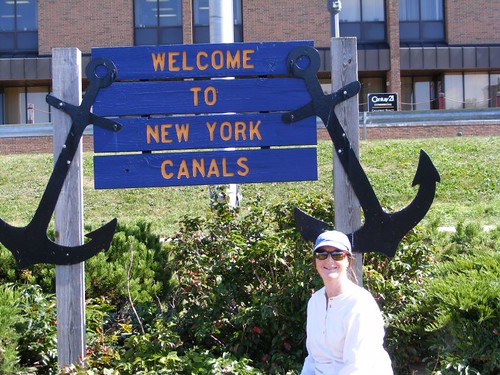
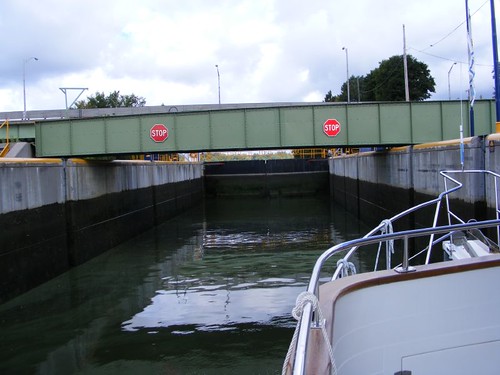

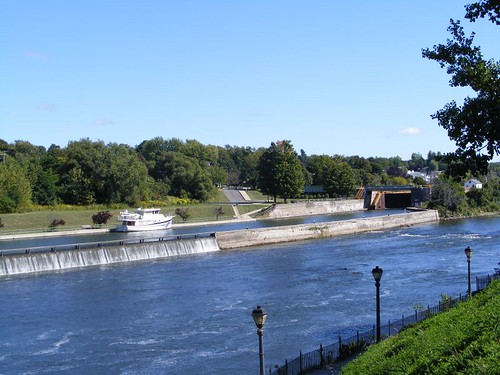
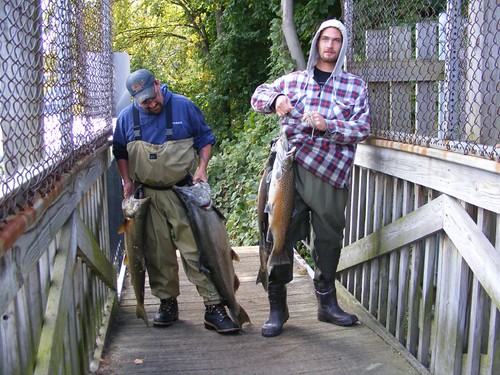
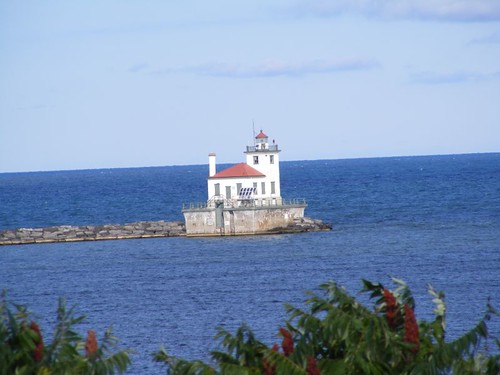

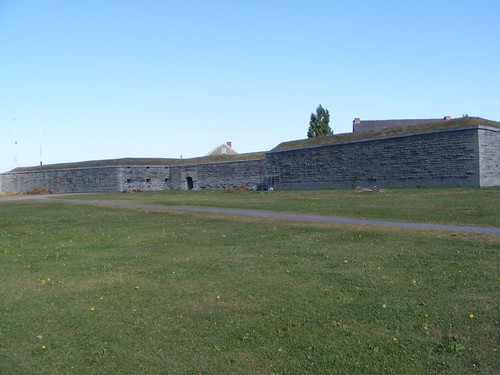
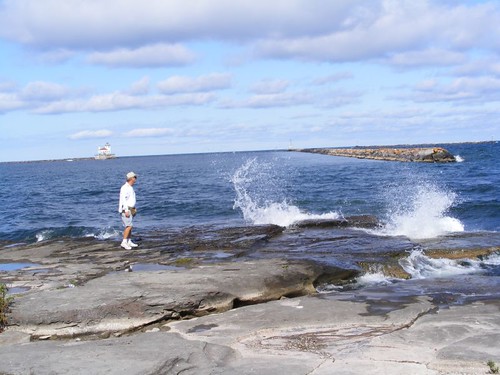









Love the flamingos...better bring them back south before the snows :).
ReplyDeleteThanks for another great post.
Bob and Dorinda